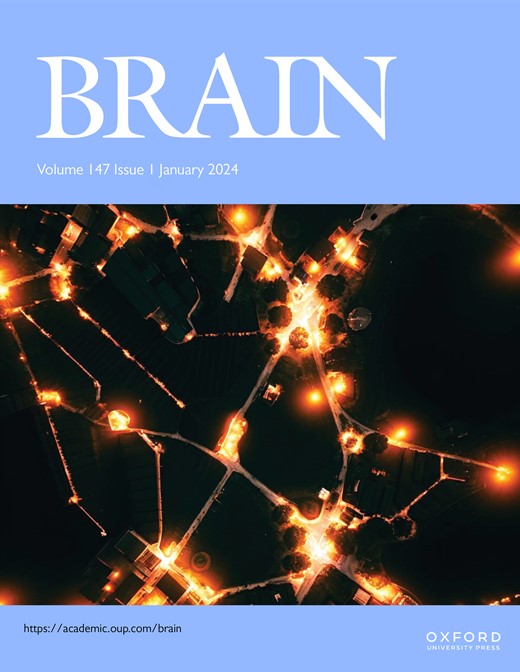治疗肌萎缩侧索硬化和额颞叶痴呆的新一代HDAC6抑制剂。
IF 11.7
1区 医学
Q1 CLINICAL NEUROLOGY
引用次数: 0
摘要
蛋白平衡和细胞内转运失调导致神经退行性变。HDAC6是神经退行性疾病的治疗靶点,在调节蛋白平衡和细胞内运输的关系中起作用。抑制HDAC6去乙酰化酶活性可促进蛋白质聚集体的自噬清除,增加微管蛋白乙酰化,从而增强微管弹性和运动蛋白-微管结合,从而促进细胞内运输,进而促进蛋白质静止。尽管有这些益处,HDAC6抑制剂治疗神经退行性疾病的进展一直受到第一代化合物选择性和cns外显性不足的阻碍。在这里,我们在肌萎缩侧索硬化和额颞叶痴呆的临床前模型中描述了下一代小分子HDAC6抑制剂EKZ-438。我们展示了EKZ-438的药理学特性,它对HDAC6具有高选择性(HDAC6的选择性是所有其他HDAC6类似物的8500倍),对HDAC6具有低纳摩尔效价(12 nM),重要的是,cns外显率(Kp,uu,脑)≥0.55,高口服生物利用度(F% = 70)。在补充的临床前体外和体内免疫标记和实时成像研究中,我们验证了选择性抑制HDAC6去乙酰化酶活性足以改善家族性和散发性肌萎缩侧索硬化症和额颞叶痴呆动物模型的病理生理蛋白平衡和细胞内运输缺陷的假设。值得注意的是,我们将这些发现扩展到人类诱导多能干细胞衍生的神经细胞模型,支持我们的发现与人类疾病的相关性。EKZ-438治疗完全恢复了SOD1 (q < 0.0001)和TDP-43 (q < 0.001)在兴奋毒性谷氨酸刺激后的蛋白平衡缺陷,并使SOD1G93A和野生型运动神经元的存活率分别提高了59% (q < 0.0001)和37% (q < 0.01),显示出体外神经保护作用。在SOD1G93A小鼠中,EKZ-438改善了16%的轴突运输(q < 0.05),运动性能提高了~ 40% (q < 0.05),血浆神经丝轻链水平降低了35% (q < 0.05),显示出体内神经保护作用。在TDP-43小鼠模型中,EKZ-438使脑部TDP-43病理减少约30% (q < 0.05),神经炎症减少约26% (q < 0.05),支持HDAC6抑制散发性肌萎缩侧索硬化症和额颞叶痴呆。此外,EKZ-438处理能提高39%的细胞内转运(q < 0.001),挽救87%的胞质TDP-43积累(q < 0.0001),恢复核TDP-43剪接活性(P < 0.05)。这些机制上的改善与几乎完全挽救人类TARDBP和C9orf72突变神经元存活一致(P < 0.0001)。我们得出结论,选择性抑制HDAC6是肌萎缩侧索硬化症和额颞叶痴呆潜在疾病改变的一种有希望的治疗方法。本文章由计算机程序翻译,如有差异,请以英文原文为准。
A next-generation HDAC6 inhibitor for amyotrophic lateral sclerosis and frontotemporal dementia.
Dysregulated proteostasis and intracellular transport contribute to neurodegeneration. HDAC6, a therapeutic target of interest for neurodegenerative diseases, acts at a nexus modulating both proteostasis and intracellular transport. Inhibition of HDAC6 deacetylase activity promotes autophagic clearance of protein aggregates and increases ⍺-tubulin acetylation, thereby enhancing microtubule resiliency and motor protein-microtubule binding, which facilitates intracellular transport and, subsequently, proteostasis. Despite these benefits, advancement of HDAC6 inhibitor therapeutics for neurodegenerative disease has been hindered by inadequate selectivity and CNS-penetrance of first-generation compounds. Here we characterize a next-generation small molecule HDAC6 inhibitor, EKZ-438, in preclinical models of amyotrophic lateral sclerosis and frontotemporal dementia. We present the pharmacological properties of EKZ-438, which demonstrate high selectivity for HDAC6 (>8,500-fold selectivity for HDAC6 versus all other HDAC6 paralogs), low nanomolar potency (12 nM) for HDAC6, and, importantly, CNS-penetrance (Kp,uu,brain) ≥ 0.55 and high oral bioavailability (F% = 70). In complementary preclinical in vitro and in vivo immunolabeling and live imaging studies we tested the hypothesis that selective inhibition of HDAC6 deacetylase activity is sufficient to improve pathophysiological proteostasis and intracellular transport deficits in animal models of familial and sporadic amyotrophic lateral sclerosis and frontotemporal dementia. Notably, we extended these findings to human induced pluripotent stem cell-derived neuronal cellular models, supporting the relevance of our findings to human disease. EKZ-438 treatment fully rescued SOD1 (q < 0.0001) and TDP-43 (q < 0.001) proteostasis defects following an excitotoxic glutamate challenge, and increased survival of SOD1G93A and wildtype motor neurons by 59% (q < 0.0001) and 37% (q < 0.01), respectively, demonstrating in vitro neuroprotection. In SOD1G93A mice, EKZ-438 improved axonal transport by 16% (q < 0.05), motor performance by ∼40% (q < 0.05), and decreased plasma neurofilament light chain levels by 35% (q < 0.05), demonstrating in vivo neuroprotection. In a TDP-43 mouse model, EKZ-438 reduced TDP-43 pathology by ∼30% (q < 0.05) and neuroinflammation by ∼26% (q < 0.05) in the brain, supporting HDAC6 inhibition for sporadic amyotrophic lateral sclerosis and frontotemporal dementia. Furthermore, EKZ-438 treatment improved intracellular transport by 39% (q < 0.001), rescued cytoplasmic TDP-43 accumulation by 87% (q < 0.0001), and restored nuclear TDP-43 splicing activity (P < 0.05) in human TARDBP neurons. These mechanistic improvements aligned with nearly complete rescue of human TARDBP and C9orf72 mutant neuron survival (P < 0.0001). We conclude that selective HDAC6 inhibition represents a promising therapeutic approach for potential disease modification in amyotrophic lateral sclerosis and frontotemporal dementia.
求助全文
通过发布文献求助,成功后即可免费获取论文全文。
去求助
来源期刊

Brain
医学-临床神经学
CiteScore
20.30
自引率
4.10%
发文量
458
审稿时长
3-6 weeks
期刊介绍:
Brain, a journal focused on clinical neurology and translational neuroscience, has been publishing landmark papers since 1878. The journal aims to expand its scope by including studies that shed light on disease mechanisms and conducting innovative clinical trials for brain disorders. With a wide range of topics covered, the Editorial Board represents the international readership and diverse coverage of the journal. Accepted articles are promptly posted online, typically within a few weeks of acceptance. As of 2022, Brain holds an impressive impact factor of 14.5, according to the Journal Citation Reports.
 求助内容:
求助内容: 应助结果提醒方式:
应助结果提醒方式:


